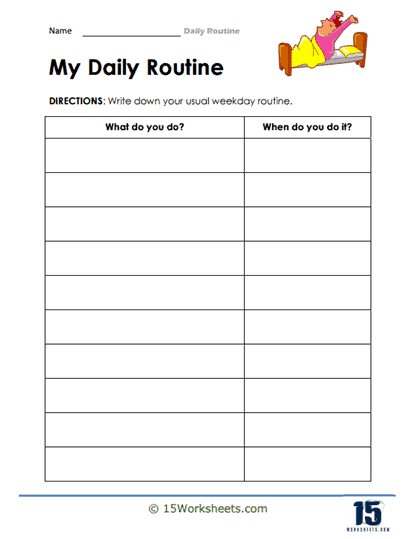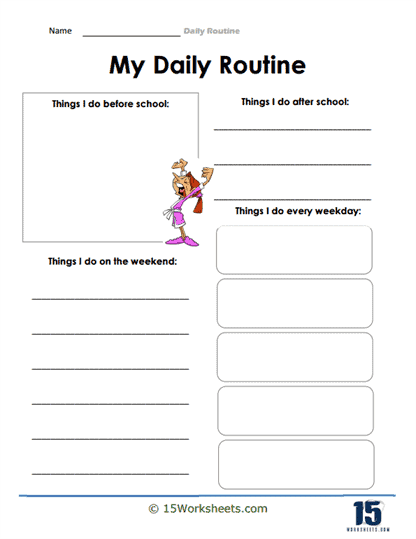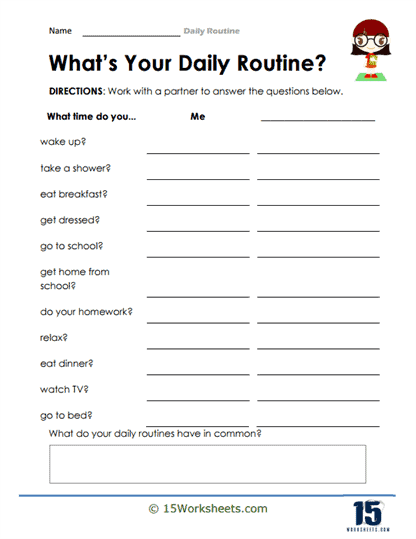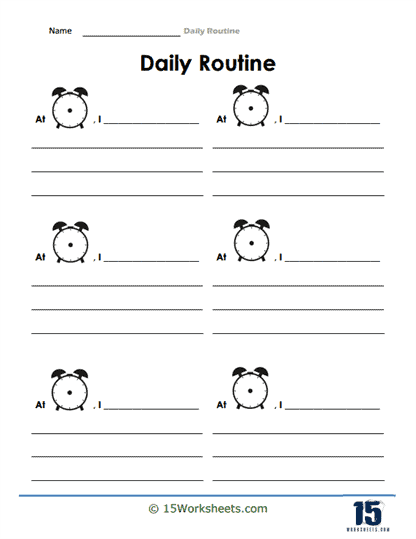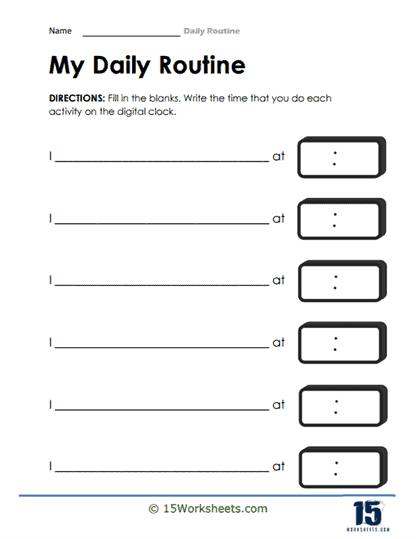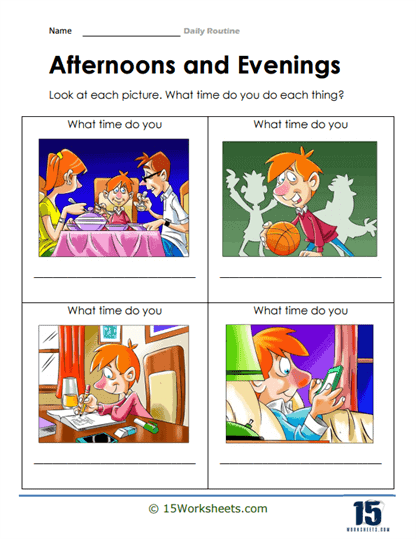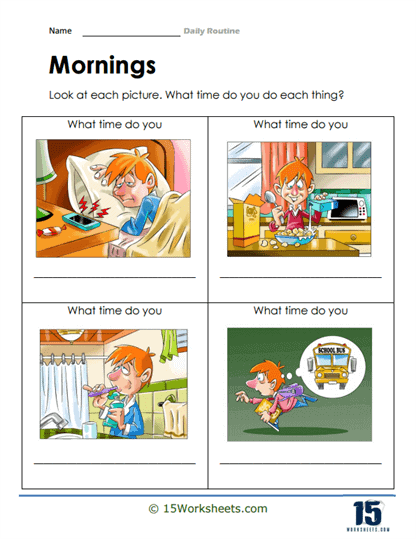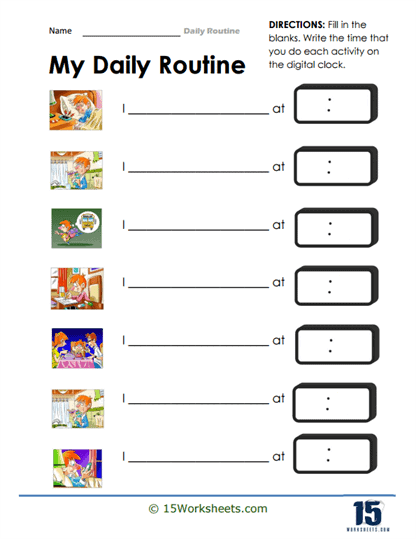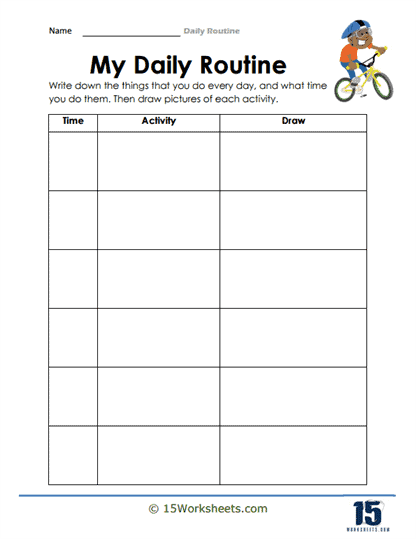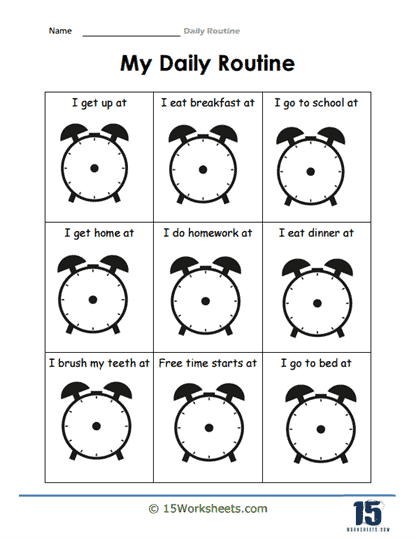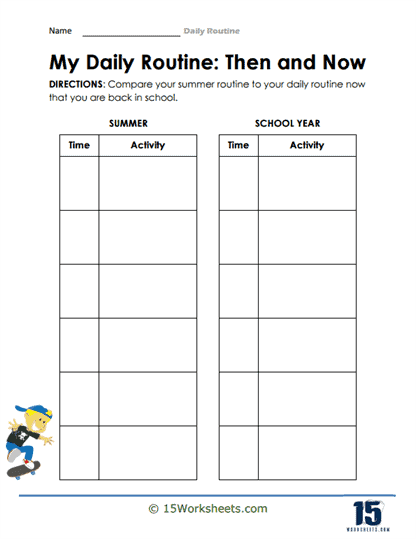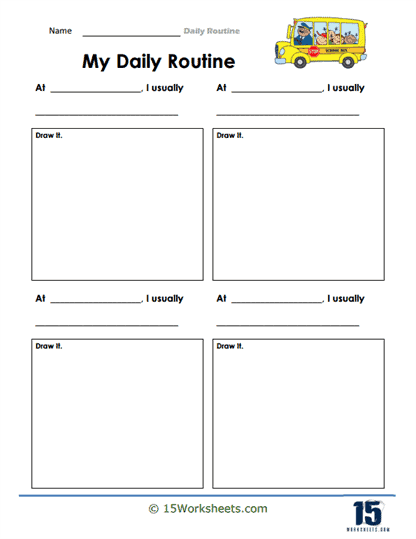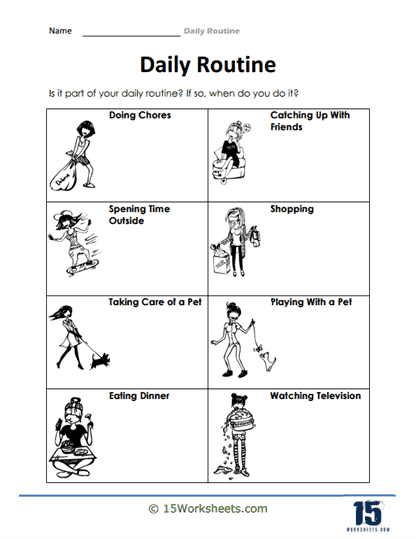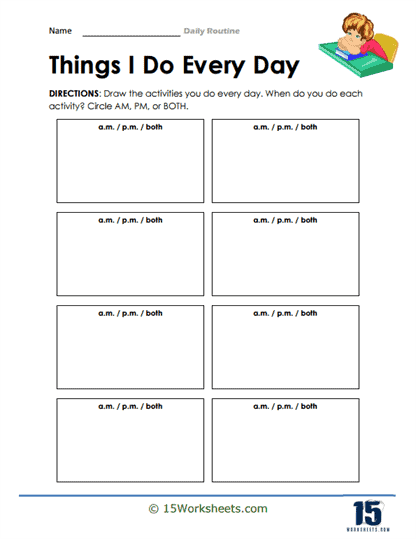Daily Routine Worksheets
All About These 15 Worksheets
Establishing a daily routine is key to fostering productivity, organization, and a sense of stability in students’ lives. This series of 15 worksheets has been thoughtfully designed to help students develop and maintain an effective daily routine. Each worksheet focuses on specific aspects of daily routines, providing guidance, prompts, and planning exercises to enhance students’ organization skills and time management.
The worksheets in this series cover various elements of daily routines, including setting goals, prioritizing tasks, managing time, self-care, and reflection. By engaging with these worksheets, students will develop the habits and skills necessary to structure their days, maximize productivity, and maintain a healthy work-life balance. These exercises aim to cultivate a sense of purpose and efficiency, empowering students to make the most of each day.
By engaging with these daily routine worksheets, students will develop crucial organizational skills, enhance time management abilities, and cultivate a healthy work-life balance. In summary, these exercises promote a sense of structure, purpose, and self-care within daily routines, empowering students to make the most of their time and achieve their goals with efficiency and balance.
A Quick Look Inside These Worksheets
Take the “Weekday Routine” worksheet, for instance. It’s a straightforward, two-column layout where students list their daily activities alongside corresponding times. This exercise encourages them to think critically about how they spend their days, from morning rituals to evening wind-downs. It’s like holding up a mirror to one’s daily life, prompting questions like, “Do I really spend that much time on TikTok?”
Then there’s the “Graphic Organizer” and “Every Weekend” worksheets, which delve into planning and reflecting on weekly activities. These tools help students identify patterns in their behavior, such as consistently procrastinating on Sunday nights. By visualizing their routines, students can pinpoint areas for improvement and celebrate their productive habits.
For those who enjoy a collaborative approach, the “Pair Work” and “Round The Clock” worksheets offer opportunities for students to discuss and compare routines with peers. These activities not only foster communication skills but also highlight the diversity of daily habits among classmates. It’s a chance to learn that while one student wakes up at 5 AM for a jog, another considers 8 AM an early start.
Time management takes center stage with “Digital Clock Time,” “What Time Do You…,” “Morning Activities,” and “My Daily Schedule.” These worksheets challenge students to align their activities with specific times, promoting punctuality and planning. Meanwhile, “Draw My Day” and “Telling Time” add a creative flair, allowing students to illustrate their routines and practice reading clocks-skills that are both practical and artistic.
Worksheets like “Then And Now,” “Illustrate Your Habits,” “When Do You Do This?,” and “AM and PM” encourage deeper reflection on personal growth and the passage of time. Students compare past and present routines, recognize changes in their habits, and understand the importance of balancing activities throughout the day. These exercises serve as gentle reminders that routines evolve, and self-awareness is key to personal development.
The Typical Daily Routine For Students
A typical daily routine for a K-12 student may vary depending on factors like the school’s schedule, extracurricular activities, and the student’s age or grade level. However, a general daily routine for a K-12 student might look like this:
Morning routine:
- Wake up
- Brush teeth and get dressed
- Eat breakfast
- Pack school bag with necessary materials (books, notebooks, lunch, etc.)
Travel to school:
- Walk, bike, take the bus, or get a ride to school
School day:
- Attend classes, typically following a schedule with multiple subjects (e.g., math, science, language arts, social studies, etc.)
- Participate in group activities, discussions, and projects
- Complete in-class assignments and take notes during lectures
- Enjoy a lunch break, socializing with friends or participating in clubs or other school activities
- Engage in physical education classes or recess (depending on the grade level)
After-school activities:
- Participate in extracurricular activities such as sports, clubs, or tutoring
- Travel home or to an after-school program
Evening routine:
- Complete homework assignments and study for upcoming tests or quizzes
- Eat dinner with family or independently
- Spend time with family, friends, or engage in hobbies and personal interests
- Attend to personal hygiene (shower, brush teeth, etc.)
Bedtime routine:
- Prepare for the next school day (pack bag, lay out clothes, etc.)
- Read or engage in a calming activity
- Go to sleep
Keep in mind that this is a general outline, and a student’s daily routine may vary based on factors such as their school’s schedule, family commitments, and personal interests.
How to Plan Your Daily Routine
Based on individual values and goals, everyone’s daily routine will differ. When you don’t have a plan, everything can seem overwhelming. The best way to plan your daily routine is to form habits that you will remain consistent with.
Everyone’s daily routine will be different based on their individual values and goals. However, all you have to do is apply a couple of general principles to your everyday routine that will help you maximize productivity and effectiveness to accomplish all your goals.
The Process
1. Prioritize Individual Values
The one thing that successful people have in common is that they design their lives in a way so that they are doing what they care about the most.
This means that before you plan your daily routine, you need to list the things you value. Understanding this will help you prioritize to achieve a work-life balance and organize your routine accordingly.
To do this, think about what is important to you- make a list if you want. Then, figure out ways to incorporate these things into your everyday routine. For example, if your priority is working out, pick a time for your fitness activity and base your entire day around that.
2. Make a Morning Routine
Some of the most productive people in the world boast about how they wake up at 4 am and have elaborated routines and tasks that they complete before the sun rises. However, there is no one time you need to follow to plan your daily routine- regardless of when you start your day, you need to have a few morning rituals that you follow each day.
Even though you don’t need to wake up at the crack of dawn each day, you need to wake up early enough so that you do not waste the day. Remember, the first thing you do when you wake up will set the tone for the rest of your day.
For example, if you make your bed right after waking up, meditate, eat a good breakfast, and then start work, your mind and body will be able to switch to being productive faster, allowing you to be in a better mood than if you start your day off by scrolling on social media and then jumping into work emails.
3. Schedule a Time to Do Less Important, More Distracting Things
Everyone has a couple of things that distract them. These things usually interfere with your daily routine as you lose track of time and end up losing the entire day. This could be checking social media, watching your favorite show, or taking multiple smoke breaks throughout the day.
Now, there is nothing wrong with these things, but when they become distractions, they can hinder our productivity. Instead of letting yourself mindlessly get distracted, allot some time so that you can engage with your distractions. If you like looking through Instagram, set out a few minutes each day in which you can do so without feeling guilty. This will help you compartmentalize and give time to distractions and essential tasks rather than allowing the former to sidetrack your entire day.
4. Do Not Multitask
Regardless of what you might have heard, multitasking does not help your performance. Not only do you end up wasting more time, but the likelihood of errors also increases. When planning your daily routine, do it one task at a time so that you are not squeezing in different things at one given time.
You can schedule tasks back-to-back if you need to save time. This will waste less time and allow you to be more efficient during the day.

